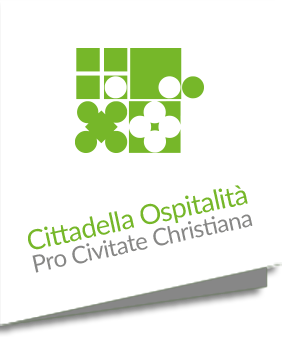The people of Assisi call this place, not far from Piazza del Comune, “Chiesa Nuova” (New Church). A document of 1398 already mentioned a small church built on the place that tradition identifies as the Paternal House of S. Francesco, an important stop for the pilgrims who follow the footsteps of the Saint. His father (Pietro di Bernardone dei Moriconi), her mother (Pica Bourlemont), his younger brother (Angelo) and Francesco – up to the age of 24 – lived here. These were days of feasts with friends, the period of the assault on the fortress dominated by the Germans, and also the time of the war against Perugia.
In 1610, for the will of Filippo III (King of Spain), a new church was built in place of the medieval one. On the top of the external portal of the church it is written what history and tradition have handed down: “The house of the parents of Francesco became a temple of God, while the prison where he was locked up by his father is still visible”.
The church overlooks the homonymous square with its bronze monument by Roberto Joppolo (1984) depicting the parents of the Saint. The simple baroque façade is made of bricks and it is vertically articulated by several pilasters and two empty niches, located in the side sectors; in the central one, instead, there is a portal with a travertine frame and a rectangular window that brings light to the inside. Shortly above, we can admire the triangular pediment. The church is an elegant Greek cross building with a major dome and four smaller ones on the sides, inspired by the Raffaello-esque style of S. Eligio degli Orafi in Rome. The interior is decorated with frescoes by Cesare Sermei and Giacomo Giorgetti, both from the XVII Century. The interior decorations are almost entirely pictorial: the central room is adorned with some pilasters painted in imitation marble and four pendentives depicting the Evangelists. The transept shows XVI Century monochrome paintings depicting various life-episodes of S. Francesco; finally, a beautiful XVIII Century painting is located on the altar.
Next to the church, inside the Convent building, there are still some rooms belonging to the ancient house of Francesco (his room, the basement – also called “prison”, where he was locked up by his father for his decision to live as a poor man – and the warehouse of his father’s shop). The entrance of the house overlooks the old street of the city, which is still preserved. With reference to this place, Dante Alighieri said: «[Here] a Sun was born in the world». The paternal house hosted two decisive events in the life of the Saint: probably, in the current area of the presbytery, Francesco dreamed of a castle with weapons and banners and heard a voice: «This is prepared for you and yours if you follow me» (Cesare Sermei illustrated this episode on the altarpiece). Francesco thought he was called to become a knight, but he did not understand that his “knighthood” was not conceived for the war, but for his divine predilection of being a brother in Christ instead. Here the young man was imprisoned under the stairs by his father, hence, he decided to answer the call with an evangelical gesture: the renunciation of his inheritance.
The house was on three floors: on the ground floor, there was the fabric of the rich merchant Pietro di Bernardone, and perhaps also the laboratories and the dye shop; on the first floor, which is the current plan of the church, there were the daytime rooms of the family; on the second floor (now disappeared) there were all the bedrooms. From this place began the Christian adventure of the Saint: the meeting with the leper, the voice of Christ heard in the Chiesa di S. Damiano, who called him to the restoration of the church, the farewell to his family, the renunciation of his property in front of the Bishop… The Convent also houses a rich Franciscan Museum and an important Library that collects precious and ancient editions. The Library preserves 60 parchment codices and illuminated manuscripts, 114 incunabula, 174 bulls and parchments (with their respective printed catalogues), cinquecentine and many ancient and rare editions – for a total of 16,000 volumes concerning Franciscanism.
